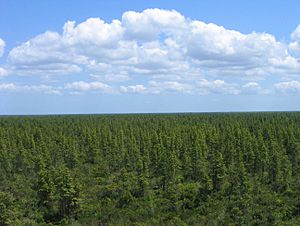Pocosin facts for kids
A Pocosin is a special kind of wetland, which is like a swampy area. It has deep, acidic, sandy soil made of peat. Peat is decayed plant material that builds up over time. The soil in a pocosin is usually full of water, except for short dry periods or during long droughts. These soils don't have many nutrients, especially phosphorus, which plants need to grow.
Pocosins are found in the southern part of the Atlantic coastal plain in North America. This area stretches from southeastern Virginia, through North Carolina, and into South Carolina. Most pocosins are in North Carolina. The Alligator River National Wildlife Refuge was created in 1984 to help protect these important wetlands.
Contents
What Makes Pocosins Unique?
Pocosins are usually found on higher ground that is poorly drained, located between streams and floodplains. Water seeps into these areas, keeping the soil wet. Often, there's a perched water table underneath, meaning water sits on top of a less permeable layer of soil.
Plants and Trees in Pocosins
Shrubs are very common in a pocosin ecosystem. This is why pocosins are sometimes called shrub bogs. The main trees you'll see are Pond pines (Pinus serotina). You might also find Loblolly pine (Pinus taeda) and Longleaf pine (Pinus palustris).
Pocosins are also home to some rare and special plants. These include the amazing Venus flytrap (Dionaea muscipula) and the sweet pitcher plant (Sarracenia rubra).
Types of Pocosins
Sometimes, people talk about two types of pocosins:
- Short pocosins have shorter trees (less than 20 feet (6.1 m) tall). They have deeper peat and fewer nutrients in the soil.
- Tall pocosins have taller trees (more than 20 feet (6.1 m) tall). They have shallower peat and soil with more nutrients.
Where the soil is not as wet and the peat is not as deep, pocosins can slowly change into pine flatwoods. Generally, the word "pocosin" can describe all shrub and forest bogs in this region. It can also include areas with Atlantic white cedar (Chamaecyparis thyoides) and loblolly pine.
How Pocosins are Formed
Pocosins are created by the buildup of organic matter over thousands of years. This matter looks like black muck. This buildup makes the area very acidic and low in nutrients. The thickness of this organic layer changes depending on where you are in the pocosin. Near the edges, it might be only a few inches thick. But closer to the center, it can be several feet thick!
The plants also change from the edge to the center. Near the edges, you'll find more pond pines, along with many titi shrubs, zenobia (a shrub unique to pocosins), and greenbrier vines. Closer to the center, the trees are usually thinner and stunted, and there are fewer shrubs and vines.
Importance for Wildlife
Pocosins are very important for migratory birds. Many different types of berries grow there, which provide food for the birds as they travel.
The Role of Fire in Pocosins
Pocosin ecosystems are adapted to wildfires. This means they need fire to stay healthy. Pond pines have a special way of releasing their seeds called serotiny. Their cones only open and release seeds after being exposed to the heat of a fire. This helps new pond pine trees grow.
Wildfires in pocosins can be very intense. Sometimes, they burn deep into the peat soil. This can create small lakes and ponds in the landscape.
Fires that happen about once every ten years help pond pines become the main tree. They also cause cane (Arundinaria) to grow more than shrubs in the understory (the plants growing under the main trees). If fires happen more often, like every year, they prevent shrubs from growing much. They also thin out the pond pine forest cover, creating a flooded savanna with grass, sedge, and other small plants on the ground.
Where Does the Name "Pocosin" Come From?
The word pocosin comes from an Eastern Algonquian word. It means "swamp-on-a-hill." The city of Poquoson, Virginia, which is in the coastal plain of Virginia, got its name from this type of geographic feature.



